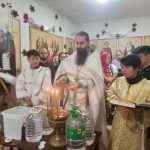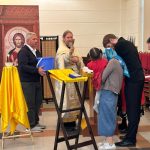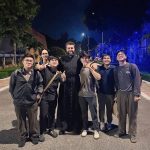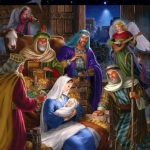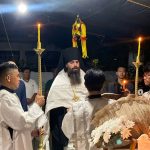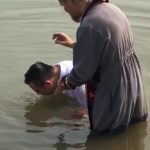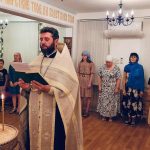Orthodoxy (derived from Greek ὀρθοδοξία – correct teaching, correct faith and glorification of God) – the original traditional Christianity founded by our Lord and Savior Jesus Christ in Palestine, was spread throughout the world by his closest disciples – the apostles, together with their successors.
This is the faith and the corresponding way of life of the Orthodox Church, which is understood as a community of independent (Autocephalous) local Churches united by Eucharistic communion.
The Orthodox people confess the true, Apostolic faith, embodied in Holy Scripture and Sacred Tradition, expressed in the Nicene-Constantinople Creed (symbol of faith) and other decrees adopted by the seven Ecumenical councils and holy fathers.
The Foundation of the Orthodox Church is the God-man Jesus Christ, the redeeming feat of His earthly life, preaching, death on the Cross and Resurrection in the first third of the first century.
After the descent of the Holy Spirit on the apostles, they dispersed to preach the Gospel of Christ throughout the world. Until the end of the first century they were able to spread Christianity in all the known countries of the Ancient world, founding there many Christian communities.

After the death of the apostles, their work was continued by their ordained bishops, who affirmed and spread the Christian faith in the lands entrusted to them.
Gradually, the Church hierarchy and its organizational structure were formed, its most important administrative centers becoming Rome, Alexandria, Antioch, Caesarea and other biggest cities of the Roman empire.
In I – IV centuries the Church suffered both from state persecution from the outside and from heresies and schisms inside itself. Both threatened its very existence. Christianity was condemned and outlawed. The defense of the Church was led by apologists, justifying and defending Christian doctrine and way of life from hostile attacks. Many Christians testified their loyalty to Christ by deeds of confession and martyrdom.
In the beginning of IV century the persecution ended with the victory of Christianity. At first, under Emperor Constantine the Great (306-337), it was equalized in rights with other religions and even gained a privileged position, being able to preach freely. Then, Emperor Theodosius I the Great (346-395) proclaimed Christianity the only state religion of the Roman Empire.

Time from IV to VIII century in Church history is called the period of the Ecumenical councils. The representatives of the entire Christian Church were gathering to clarify and protect the purity of the Orthodox creed from various heretical errors (arianism, nestorianism, monophysitism, monophelitism, iconoclasm) and establish a single canonical order, with the active support of the imperial authorities. Thus the faith in the Holy Trinity, the God-manhood of Christ, the dignity of the Virgin, icon worship, etc. were confirmed.
In IV century monasticism emerged and was flourishing, since then it becomes an essential part of Orthodoxy. The leading centers of monastic life were Egypt, Syria and Palestine. The founders of monasticism are considered to be the venerable Anthony the Great, Macarius of Egypt, Pachomius the Great, Hilarion the Great, James of Nisibia and others. The Monastic desire to embody the ascetic Evangelical ideal in earthly life resisted the worldliness of the Church, protected it from worldly temptations.
In V century pentarchy was formed – the United Ecumenical Church with five Patriarchates (Rome, Constantinople, Alexandria, Antioch and Jerusalem), with primacy honor given to the Roman pulpit.
In VII century the homeland of Christianity – Palestine together with the most ancient Christian lands (Syria, Egypt, Asia Minor) were captured by Muslim troops. De facto, only Constantinople Church remained independent on the East.
By the end of the first millennium, a number of socio-political, cultural and doctrinal differences between the Eastern and Western parts of the Christian Church took place. As a result, in 1054 the Roman Church fell away from unity with the Eastern (Byzantine) Church. This tragic event, called the Great schism of the Church, was much aggravated by the Crusades in 11-13 centuries and until now is an unhealed wound on the body of the Church.
The Russian Orthodox Church has more than a thousand years of history. According to tradition, the Holy Apostle Andrew the first-called, preached the Gospel in the future Russian lands. The spread of Christianity in Russia was facilitated by its proximity to such Christian countries as the Byzantine Empire and Bulgaria.

In the IX century western Slavonic countries were enlightened by the Holy equal-to-the-apostles brothers Cyril and Methodius-the enlighteners of the Slavs, the creators of the Slavonic alphabet and translators of Scripture and Worship texts into the Slavonic language.
In 860 AD, under the Patriarch of Constantinople St. Photius, the Kievan princes Askold and Dir were baptized. This first attempt to baptize Russia at the state level, unfortunately, ended with failure and pagan reaction.
In 954, Princess Olga of Kiev, the first Christian ruler of the Rurik dynasty, was baptized.

In 988, her grandson, Prince Vladimir makes the final decision and performs the Baptism of Rus. The newly formed Russian Church becomes one of the metropolitans of the Patriarchate of Constantinople, which it remained for five centuries. The Metropolitan of Kiev was appointed from the Greek, by the Patriarch of Constantinople. In 1051, the first Russian was placed on the primatial throne, Metropolitan Hilarion, the most educated man of his time, a remarkable Church writer.
Orthodoxy had a powerful influence on the development and flowering of Russian statehood, education, culture and spiritual life of the nation. Magnificent temples were erected, monasteries were founded, school education was developed, uniform legislation was created, literature and other arts flourished, social disproportions were softened.
The founders of monasticism in Russia are the venerable Anthony and Theodosius of Kiev, who initiated the famous Kiev-Pechersky Lavra. The outstanding writers of the Russian Church were Metropolitan Hilarion of Kiev, Reverend Nestor the Chronicler and others.
In the XII century the Russian Church was the only force that resisted feudal fragmentation, conflicts of princes and urged to preserve fraternal unity for the sake of the country and the people.
Russian Church was not much affected by the Tatar-Mongol invasion which put the Russian lands under the rule of the Golden Horde. The Church became the consoler for the people, its spiritual inspirer for the reconstruction of the political unity of Russia. Spiritually, materially and morally it contributed to the future victory over the enslavers.
Russian Primates were the spiritual leaders and assistants of the Moscow princes in the unification of the scattered Russian principalities around Moscow. Metropolitan Alexey (1354-1378) brought up the Holy Prince Dimitri Donskoy. He, as later Metropolitan Jonah (1448-1471), using the force of his authority helped Moscow Prince in ending the feudal turmoil and preserving the state unity. The great ascetic, the monk Sergius of Radonezh gave his blessing to Dimitri Donskoy for the greatest feat of arms – the battle of Kulikovo, which became the beginning of Russian liberation from the Mongol yoke.

Russian monasteries were the guards over the Orthodox faith, national identity and culture from negative Western influence. In XIV-XV centuries, around 180 new monasteries were founded in Russia. The main monastic centers were the Pochaev Lavra founded by the monk Job (now Western Ukraine) and the Trinity-Sergius Lavra founded by the monk Sergius of Radonezh on the East (near Moscow). In this prosperous monastery, the marvelous talent of the icon painter St. Andrei Rublev flourished.
In 1448 the Russian Church became independent from the Patriarchate of Constantinople (Byzantine empire was entirely conquered by the Turks in 1453). Metropolitan Jonah, appointed by the Council of Russian bishops, received the title of Metropolitan of Moscow and all Russia.
In 1589 Metropolitan Job of Moscow became the first Russian Patriarch. The Eastern patriarchs recognized the Russian Patriarch as the fifth in honor. By that time the other four ruled their Churches in countries all occupied by the Muslims.
In the Troubled times of the early XVII century the Russian Church helped to overcome the trials befell on the state and the nation – the civil war and the Polish intervention. The ardent patriot Patriarch Ermogen (1606-1612) was the spiritual leader of the militia of Minin and Pozharsky. It is impossible not to recall the heroic defense of the Trinity-Sergius Lavra from the Polish-Lithuanian invaders in 1608-1610. It is significant that the first king of the new dynasty became the son of Patriarch Filaret (1619-1634) Mikhail Romanov.
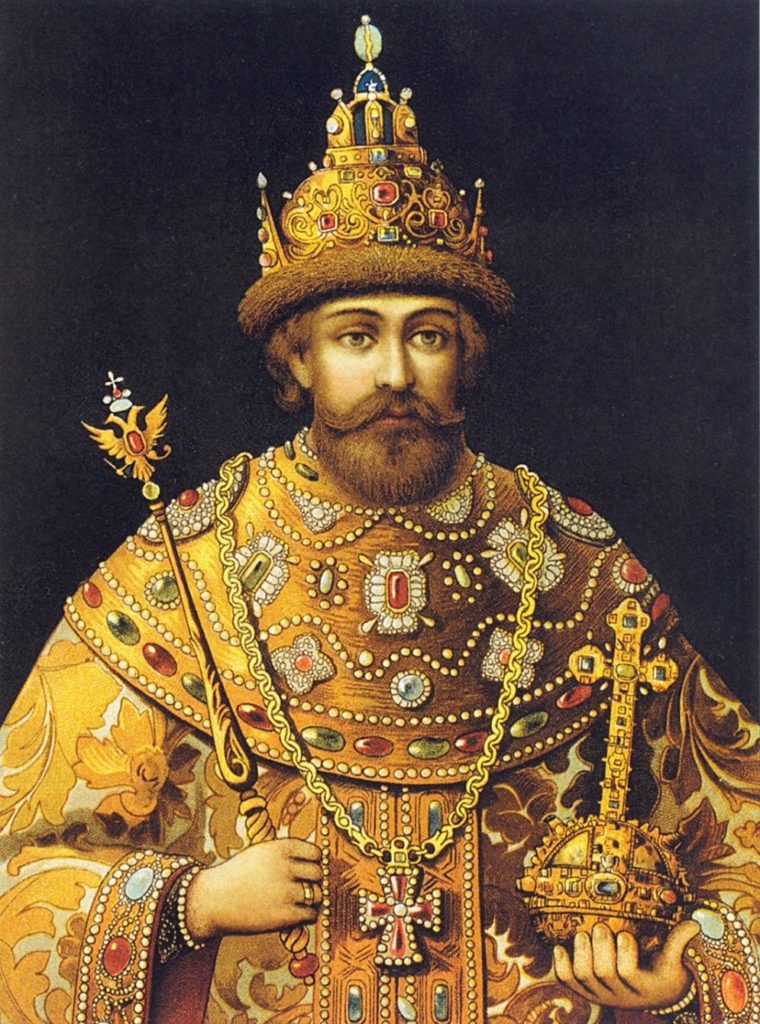
As a result of Peter I reforms, the Patriarchal administration was abolished and the Church became governed by the Holy Governing Synod, a collegial Council consisting of the Church and the state representatives headed by the Tsar.
The Synodal period lasted nearly two hundred years. At that time, the Russian Church paid special attention to the development of spiritual education and missionary work on the outskirts of the country and beyond. Restoration of old and construction of new temples was conducted.
The XIX century was marked by the activity of remarkable theologians, Church historians, philologists, Orientalists. It gave great examples of Russian Holiness: outstanding saints Filaret Drozdov, Innokenty of Kherson, Ignatius Bryanchaninov, Theophan the Recluse, St. Seraphim of Sarov, old monks of Optina and Glinskaya monasteries.
In 1917, immediately after the February revolution, the all-Russian Church Council (1917-1918) was convened, the main act of which was the restoration of the Patriarchal administration of the Russian Church. Metropolitan Tikhon of Moscow was elected Patriarch of Moscow and all Russia (1917-1925) at this Council.

Under his leadership, the Church tried to heal the revolutionary turmoil, to calm the destructive passions and stop fratricidal strife. However, the Bolsheviks who came to power, professed atheism and looked at the Church as their enemy. Therefore, they launched against the Church the most terrible persecution in history. Their goal was the complete the destruction of the faith and the Church in the USSR. Bishops, priests, monks, laity were subjected to all kinds of repression: ridicules, mockeries, tortures, executions, imprisonments, camps and death penalty. Throughout the country, churches, monasteries, religious schools were closed; there was a company of mockery over the Orthodox faith and Church shrines.

By the beginning of the great Patriotic war, the organizational structure of the Russian Church was almost completely eliminated. Only a few bishops remained free in the country, only a few hundred temples were opened, and most of the surviving clergy were in camps.
The disastrous outbreak of war with Nazi Germany prompted the Soviet leadership to seek help from the Church. Churches were opened for worship, religious educational institutions, bishops and other clergy were released from the camps. During the war, the Russian Church has traditionally provided not only spiritual but also material support to the warring people defending their Fatherland.
A partial warming in the relations with the state took place but the Church was constantly under state control and restrictions of its activities.
The so-called “Khrushchev thaw” turned into new persecutions for the Church, when thousands of churches were forcibly closed throughout the Soviet Union.
At the local Council of 1971 there was a reconciliation with the old believers who broke away from the Church as a result of rejection of the reforms of Patriarch Nikon (1652-1666). The decline of the state-atheistic system was marked by the celebration of the Millennium of the Baptism of Russia in 1988. The Beginning of Perestroika gave a new impetus in Church-State relations. The dialogue between the authorities and the Church began on the basis of recognition of the huge historical role of Orthodoxy in the fate of the country, its invaluable contribution to the formation of morality and culture of the nation

The revival of the Russian Orthodox Church began, which is continuing till today. People reached out to Christ and His Holy Church. Archpastors, pastors, laymen began to work zealously to recreate the full-blooded Church life. Thousands of temples and hundreds of monasteries are being built and restored from the ruins. The education, enlightenment, charity, missionary work and public services of the Church are steadily expanding. At the same time, believers have to resist all sorts of attempts to shake, split the Church both from the outside and from within, to subordinate It to worldly interests.
His Holiness Patriarch Alexy II (1990-2008) led the Church revival in the difficult conditions of the collapse of the USSR. Russian Orthodox Church outside of Russia (ROCOR), which was formed as a result of the revolutionary turmoil and the Russian emigration caused by it, reunited with the Russian Orthodox Church in 2007.

His Holiness Patriarch Kirill is continuing the work of reviving the Russian Church. In 2019 the last part of Russian Orthodoxy abroad – the Archdiocese of Western European parishes of the Russian tradition – joined the Moscow Patriarchate.

The majority of Orthodox believers living in Russia, Ukraine, Belarus, Moldova belong to the Russian Orthodox Church today. Orthodoxy also prevails in the countries of the Balkan Peninsula (Greece, Serbia, Bulgaria, Romania, Northern Macedonia, Montenegro), in Georgia and Cyprus.
In addition to these countries, the Orthodox live in other countries where other religions prevail. One such country is the Philippines.
Russian Orthodox Church in the Philippines
The first Russian priests visited the Philippines more than 150 years ago. In times of great research trips the Russian Empire did not remain aloof. And, of course, each expedition was accompanied by an Orthodox regimental priest. So, count E.V. Putyatin during the diplomatic mission to Japan on the frigate “Pallada” visited the Philippines on his way. This journey was documented in detail by Goncharov in the novel with the same name “Pallada”. From there we know that on this trip they were accompanied by the famous missionary and orientalist Archimandrite Abbakum (Chestnoy). In 1854, the “Pallada” arrived to Manila and, of course, on Sundays the Orthodox Liturgy was served there .
The next important milestone in the activity of the Orthodox Church in the Philippines was 1934, when on the basis of the request of the Russian Diaspora in Manila, the Bishop of China and Beijing Victor (Svyatin) founded a parish in Manila, in honor of the Iveron icon of the Mother of God. It existed until 1945 when it was destroyed during liberation of Manila from Japanese by American army.

Four years later, in 1949, after the Communists came to power in China, about 6 thousand Russian refugees left Shanghai. From all the countries in the world, only the Republic of the Philippines agreed to accept them for some time. The Russians were encamped on the small island of Tubabao. And the first arranged buildings were two churches: in honor of the Archangel Michael and in honor of Seraphim of Sarov. And the temple of the Mother of God was arranged of the former American marching church.

The spiritual leader of the refugees was St. John (Maksimovich) who arrived to the island together with the others. The Filipinos who saw him on the island of Tubabao are still alive. Also alive is the legend that while St. John was on the island, not a single typhoon reached it.
St. John (Maximovich) in the Philippines.
The Russians were going to stay on the island for 2 months only, but because of different problems they stayed for more than two years. St. John periodically traveled from the Philippines to other countries, primarily to the United States, to organize the immigration of refugees there. And it happened, in 1951 almost all Russian refugees left the Philippines.
The next Liturgy was served on Tubabao only 62 years later, in 2013, when the ROCOR clergy: priest Seraphim Bell and deacon Siluan Thompson, visited the Philippines. During preparation for this trip, the monk Philip Balingit with the help of Russia built a chapel in the same place where the Russian temple was located.

Unfortunately, this chapel as well as many other buildings on Tubabao was destroyed in 2013 by typhoon “Yolanda”, one of the mightiest in the history of observation. Priest Kirill Shkarbul who serves in the parishes of the Russian Orthodox Church in Taiwan, flew to the island to help the victims.
At the same time, a large group of Aglipayan priests from the island of Mindanao (followers of the teachings of Gregory Aglipay, who broke away from the Roman Catholic Church more than 100 years ago) began to be interested in the history of Christianity and, as a consequence, Orthodoxy. Having learned that a priest of the Russian Orthodox Church was visiting the Philippines, the aglipay communities asked father Kirill to visit them with a lecture on Orthodoxy. Thus began the mission of the Russian Orthodox Church among Pilippino people. After the catechism, in 2015 a number of baptisms were performed in the waters of the Pacific Ocean, when thousands of people were joined to the Orthodox Church.


Of course, the Church authorities could not ignore the Orthodox communities in the Philippines and other Southeast Asian countries. In October 2016, the Holy Synod appointed Bishop of Solnechnogorsk Sergiy Chashin, who was the head of the Administrative Secretariat of the Moscow Patriarchate, to manage parishes of the Moscow Patriarchate in Vietnam, the Philippines, Singapore, Indonesia, Malaysia, Cambodia, Laos, North Korea and the Republic of Korea. His Eminence began work with the renewal of the parish in honor of the Iveron icon of the Mother of God in Manila, on Easter in April 2017. The parish united Orthodox people of many nationalities, but Orthodox Filipinos interested in Russian culture became its backbone. In 2018, by the decision of the Holy Synod, the Patriarchal Exarchate of Southeast Asia was established, with 4 dioceses: Korean, Singaporean, Thai, Filipino-Vietnamese.

Next year, by the decision of the Holy Synod, his Eminence Pavel was entrusted to be the ruling Bishop of The Philippine-Vietnamese diocese with the title of Metropolitan of Manila and Hanoi. At the same time, several Filipino senior men of parishes were ordained to the priesthood.

Actually there are about 30 parishes of the Russian Orthodox Church in the Philippines. Parishes exist in different parts of the country on the islands of Luzon, Mindanao, Cebu and Leyte. These parishes are supported by 6 priests, among whom there are Filipinos, Russians, Americans. Services are held in Tagalog and Cebuano languages, the translations of the main liturgical texts have already been made.

Pastoral visit of the Bishop to the village Kinabalu, Sarangani province, island of Mindanao.
Orthodox priests incessantly pray God for the living and the departed, visit the sick and weak people, sanctify their homes, fields, and transport of Filipinos.
Settlements of Orthodox communities are also being improved. With help from Russia, beautiful churches are being built there becoming the most attractive buildings in the surroundings.


Remembering the words of the Apostle James “faith without good actions is dead”, the Russian Orthodox Church organized a social service. In almost every parish, Orthodox volunteers regularly feed the starving Filipino children. Also, volunteers of the Orthodox Church travel to poor areas of the island holding talks and practical classes on the rules of hygiene and healthy eating. The Church also helps people who find themselves in a difficult life situations.


The Orthodox Church did not stand aside during natural disasters. During Typhoon Yolanda and during mighty earthquakes, priests and volunteers traveled to the destroyed areas, helping with water, food and even with the rebuilding ruined homes. So in the North of Cebu, more than 100 houses were built on the funds of the Church, for the victims of the Typhoon.

The Russian Orthodox Church gives Filipinos the opportunity to receive a qualitative education both in the Philippines at the training center in Davao city and in spiritual academies in Russia. The talented boys and girls from towns and villages are annually sent to St. Petersburg to get a high-grade education.

The Church also plays an important role as a mediator for strengthening friendship and cultural exchange between Russia and the Philippines. Russian priests, in cooperation with the administration of educational institutions and settlements, participate in folk festivals and conduct cultural lectures. Professional singers from Russia also regularly come to the Philippines, holding charity concerts and introducing the locals to the rich Russian culture.

Participation of Orthodox singers from Russia at the Barangay day in Arakan, Cotabato.
The Church pays special attention to work with the youth. Unfortunately, it is no secret that young people due to the lack of worldly experience often find themselves in difficult situations associated with drugs, excessive alcohol consumption and crime. Therefore, it is especially important to educate them. In addition to lectures, the Orthodox Church regularly holds youth camps, where young people learn more about their culture, learn to get joy and pleasure from creative activities.


In conclusion, we can add that the Lord himself especially glorified the Orthodox icon of the Mother of God “Holy Virgin” icon connected with the last week before the Easter Day or “Perpetual health” in the Philippines. This icon was taken from the Orthodox monastery of Keras in Cyprus before the 15th century by a Venetian merchant. From the Chronicles we know that since 1499 it was already in the Church of St. Matthew in Rome. A copy of this icon was brought to the Philippines in 1906. At the moment, this icon is located in the temple of Baklaran, there is always a lot of praying people near it, masses are served every hour, even miracles are performed. The iconography itself contains Greek letters-titles, an angel in his hands holds an Orthodox eight-pointed cross, and the image of the iconography itself is very familiar to any Orthodox person.
The icon of the Mother of God “Perpetual health”, venerated in the Philippines (on the left), clearly visible Greek letters, which indicates the Greek origin of the icon, and “Holy Virgin of Passions” icon connected with the last week before the Easter Day, venerated in the Russian Orthodox Church (on the right)
So the history of the Russian Orthodox Church in the Philippines is lasting more than 150 years and there are no black pages in this history. According to Metropolitan Sergius of Singapore and Southeast Asia, the head of the Patriarchal Exarchate in Southeast Asia: “we welcome President Duterte’s call to expand the Russian Church presence in the Philippines, and we hope that we will be able to justify the high trust, and we believe that this will benefit the Philippine people … We pray that God will send peace and prosperity to the Philippine land”.
Metropolitan Pavel of Manila and Hanoi





